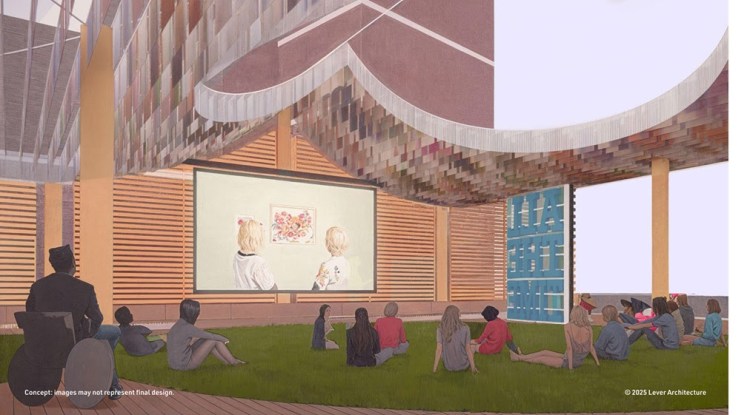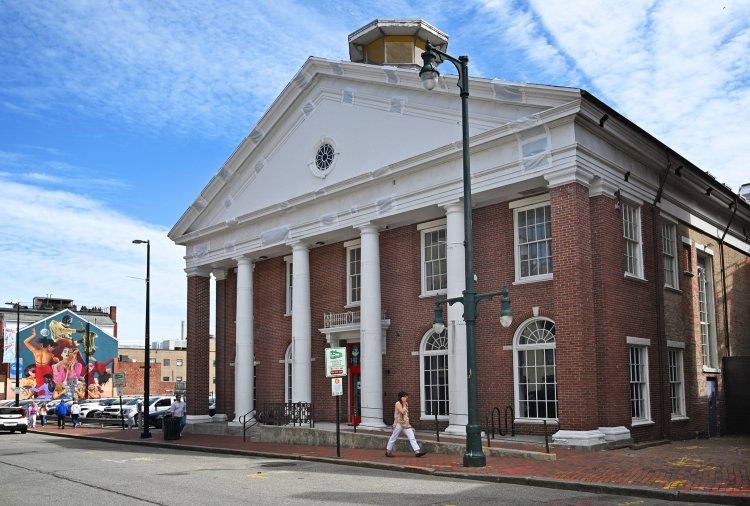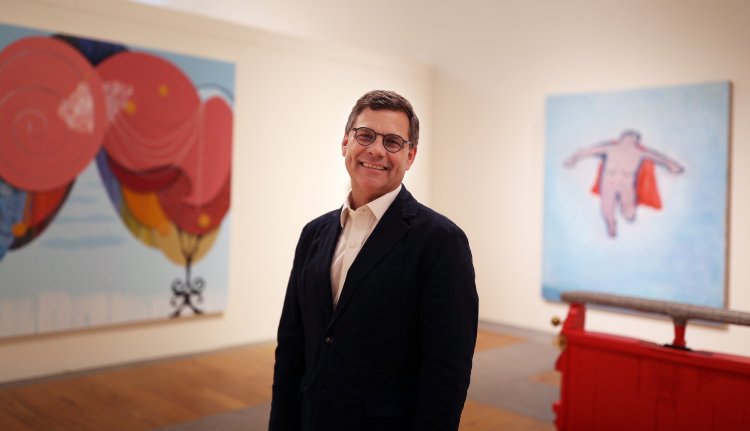

The Portland Museum of Art shared a preliminary concept design by Lever Architecture for a temporary program space at 142 Free St. (Rendering by Lever Architecture and courtesy of the Portland Museum of Art)
PORTLAND — The city has approved a demolition permit for the former Children’s Museum building at 142 Free St., and the Portland Museum of Art will likely begin tearing it down next week.
A few weeks ago, PMA Director Mark Bessire spoke about what will replace the white columns and brick façade. The Portland Museum of Art went through months of public meetings and court hearings to tear down the building that was home, at various times, to the Children’s Museum and Theatre of Maine, the Chamber of Commerce, a church and a theater. Now, the PMA plans to build a sweeping new wing of the museum on that site.
But the existing building will come down well before that project is shovel ready. So the museum plans to temporarily use the property as a public space for art, performances and community events.
What will that interim space actually look like?
“Gorgeous,” Bessire said. “Fantastic. Beautiful.”
When the city approved the demolition permit on Thursday, the museum finally released a preliminary concept design that shows a pavilion on that site. In the rendering, people sit on the grass under an awning, watching a video screen.
Officials at the Portland Museum of Art promise that they will be giving the public more details soon about the next steps for their expansion, and they have plans to share regular updates on a website for the project.
But for supporters and stakeholders, many questions still remain about the future. Four months have passed since Greater Portland Landmarks announced that it would end a lawsuit over the demolition of 142 Free St., clearing the way for the PMA to proceed.
“I would love to see them making more concerted outreach not just to us, but to the community,” said Kate Lemos McHale, executive director of Greater Portland Landmarks.
‘RESPECTING THE PROCESS’
In 2022, the Portland Museum of Art unveiled a plan for a major expansion of its downtown campus, with its centerpiece an “architecturally significant” building at 142 Free St. The initiative, called “The PMA Blueprint,” would more than double the museum’s footprint with free galleries, performance space, a photography center and a rooftop terrace. Leaders did not set an official timeline for the project but at one point said it would be completed in 2026. The fundraising goal for the project was initially $85 million but quickly grew to $100 million.
The Portland Museum of Art already owned the neighboring property, which it bought in 2019 from the Children’s Museum and Theatre of Maine. The deal enabled the children’s museum to move to its current location on Thompson’s Point, and opened the door for the art museum to expand.
To enable new construction, the museum asked the city to remove a historic designation that prevented the demolition of the existing building. That was nearly two years ago — and the debate that followed was bruising and divisive. When the Portland City Council ultimately agreed to the change, Greater Portland Landmarks sued the city. A judge ultimately sided with the city and the museum, and the preservation nonprofit decided in April not to appeal.
Museum officials said their commitment to the expansion has not wavered, but acknowledged the past two years slowed their momentum.
“There is no doubt that it slowed things on the fundraising side during that period of time,” deputy director Elizabeth Jones said. “But we intentionally did not push it out as much as we could have. We weren’t like, ‘Hey, hey guys, look at us! We’re trying to raise all the money for Blueprint!’ when there were questions that were put out into the media and into the public sphere about what we could do with that building. Now that that’s done, now that that’s over, now that there was no standing for that appeal, we can move forward confidently in that process.”
The end of litigation did jumpstart fundraising: In the last three months, the museum raised $2.5 million to push the campaign total over $50 million so far.
“What funder would give to a project with uncertainty about whether or not it’s going to actually happen?” said Erik Hayward, president of the board of trustees. “Having that cleared really allows us to move forward at the pace that we’ve intended all along.”
But $50 million is still only half of the current goal for the project.
The museum has an architecture firm and a concept design. The next step would be to develop construction plans and apply to the city for site plan review. Officials said they won’t start that step until they have raised a certain amount of money.
“It’s respecting the process,” Bessire said. “You don’t move into design development and make those investments until every box has been checked.”


The former Children’s Museum and Theatre of Maine at 142 Free St. will likely be demolished next week. (Shawn Patrick Ouellette/Staff Photographer)
HOPING FOR THE BEST
So what is that amount?
Bessire said the board will make that decision. Hayward said the trustees are still deliberating.


Portland Museum of Art Director Mark Bessire stands in the Payson Wing of the museum in 2021. (Ben McCanna/Staff Photographer)
“I couldn’t give you a number,” he said. “I can assure you that there will be a threshold at which we’re comfortable proceeding with submitting construction documents.”
Spokesperson Marcie P. Griswold said in May that the museum had entered “an 18-month phase focused on advancing schematic design, engaging the community and building philanthropic momentum.”
That’s the closest the museum has come to putting a timeline on this next phase, but officials have declined to say more about when they will bring plans to the city for review. In June, the museum applied for the demolition permit for 142 Free St. An attorney for the museum previously suggested in public meetings that it would not tear the building down until the city had approved plans for the new wing, but nothing ever came of that proposal.
Museum leaders say the building is sitting idle and underused. Once it’s gone, the property will be converted into a space for outdoor films, music and events. While they initially called the space a “temporary park,” they’re now describing it as an interim pavilion or a program outpost. They said they will work with arts organizations and community partners to fill the calendar, seeing it as a preview of sorts of the type of events they want to host in the museum’s new wing. They cited Classical Uprising, Maine Outdoor Film Festival, Hogfish and Creative Portland as early partners in that space.
“The building was never conducive for the mission of the future,” Bessire said. “This new space would be a way of getting people ready for what’s coming.”
They also said the demolition schedule outside needs to align with the exhibition schedule inside. If the museum has any works on loan inside the museum, they can’t do construction that could create vibrations.
“Work in a museum environment is highly complex, requiring strict management of environmental conditions and vibrations,” Mike Brown, head of campus sustainability, said in a statement. “By threading the needle now, we’re able to safely hang multiple ambitious exhibitions scheduled for October 2025 through next year.”
The plans are also a response to the issues they say they’ve seen in the Arts District, where a working group has been meeting for months to discuss concerns around trash and vacant storefronts. The museum is working with partners from that group to sponsor banners featuring artwork by renowned Maine artists; those will go up on light poles along Congress Street this month.
“It’ll feel like an invitation,” Griswold said. “We hope that domino effect will buoy the neighborhood.”
But the museum’s plans for the interim pavilion space came as a surprise to some people in that neighborhood.
C.J. Opperthauser is the executive director of the Friends of Congress Square Park, a nonprofit that organizes nearly 200 free events and activities in that space every year. He’s also involved in the Arts District working group and is constantly thinking about how to facilitate a public space that is open to all people. The museum’s announcement prompted him to pen an op-ed in the Portland Press Herald encouraging people to volunteer and donate to support Congress Square Park.
“I was at first surprised and concerned that people’s energy and resources were not going toward the already existing public spaces,” Opperthauser said.
He later met with museum officials to learn more about their plans and discuss possibilities for collaboration. He said he’s feeling optimistic about their ideas — and the expansion. When the museum released its concept design, Jones, the museum’s deputy director, said in a news release that collaboration with Friends of Congress Square Park is a major goal.
“The vision that they have for their new expansion will add a lot to the neighborhood, and I would suspect it would bring more people into our space and make it more vibrant,” Opperthauser said. “Assuming they are going forward with putting down the temporary park, that’s better than it being completely blank or a parking lot. But we’re watching from the other side of the street, just observing and hoping for the best.”
LOOKING AHEAD
Greater Portland Landmarks previously sent a letter to the museum asking them to hold off on demolition until construction is ready to begin. Lemos McHale said she has been in touch with the PMA about their steps to document the building and salvage materials. Griswold said that the staff is actively responding to requests from individuals about specific items.
A major concern for Greater Portland Landmarks was whether the demolition of 142 Free St. would jeopardize the surrounding historic district or prevent developers from accessing historic tax credits. The city has confirmed that it will not. But Lemos McHale said the nonprofit is still worried that this demolition will set a precedent for others and be the start of a pattern. She previously worked in New York City, where she said the Landmarks Preservation Commission would only approve a demolition in a historic district at the same time it approved its replacement. No such requirement exists in Portland.
“That is definitely a conversation that we want to have with the city, with the planning department, with the councilors, with the city manager and the mayor,” she said. “I know that we just overhauled the land use code, and there may not be a lot of appetite for further adjustments, but this really does stand out as being a case that maybe falls through a crack, that a policy change could really help in the future.”
Museum leaders said they are grateful that Greater Portland Landmarks did not pursue an appeal. In the meantime, they’re planning to update the website for the expansion project. More than 135,000 people visited the museum in 2024, an increase over the previous year, and a number that makes the museum staff optimistic.
“Through the process, we’ve learned that we don’t want to get too far ahead of ourselves,” Bessire said. “We need to be patient with our community and everybody that’s here, so that everybody’s coming along with us. We do feel strongly from our audiences that there’s much more support for where we’re headed than opposition.”


















